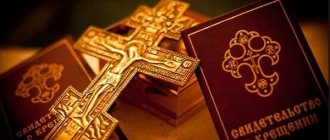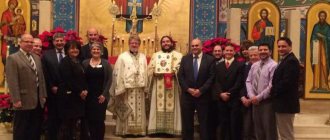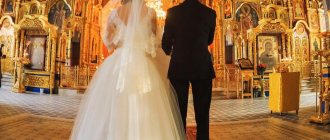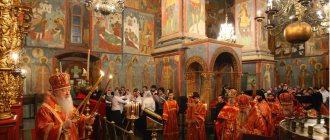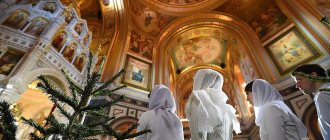Any system of social interaction must be based on certain rules and fixed methods of mutual influence. It is difficult to imagine a state or any other significant society without a certain system of behavior within this society.
The Church of Christ, which was founded by the Lord Himself, in its spiritual meaning is undoubtedly higher and greater than any rules and systems. However, the Church is in a fallen world; ordinary sinners go to it. Therefore, it is absolutely necessary that there be a clear and understandable way of organizing interaction between members of the Church.
General rules of conduct in church
The church charter is a huge collection of rules to which clergy and Christians who visit the temple are subject. In the Orthodox world these dogmas are revered in a special way. For novice parishioners, there is even a Sunday school that teaches how to behave correctly as a churchgoer.
General rules of conduct in church
Appearance
Going to church is an important event for any Christian believer. The Temple of the Lord does not accept frivolity or a condescending attitude, and therefore, before going there, one must bring oneself into a form that complies with the regulations. For women and men, the rules are significantly different, but absolutely all parishioners must have a cross on their body, given to them at baptism. It is worth remembering that church is not a place for entertainment or dating, and therefore you need to look modest.
Rules for women
According to church canons, women are allowed to enter the temple only with their heads covered and in long skirts or dresses. During services they occupy the left side of the parish, and during monthly allocations they stand closer to the door, not approaching the altar. The same rule applies to those who have recently given birth. They are allowed to attend church only on the 40th day after giving birth, when the priest will read a cleansing prayer over them. Orthodox dogma prohibits women from:
- wear clothes that are too short or tight;
- wear revealing dresses that excessively expose the body (including a deep neckline);
- do bright, provocative makeup;
- use strong perfume.
Rules for men
The church is more lenient towards the stronger sex, but there are also restrictions for men:
- Before entering the temple, you must remove your headdress;
- clothing must be neat and clean;
- It is not allowed to wear a robe or tracksuit;
- the face should be thoroughly shaved;
- several hours before attending church you should not drink alcohol or smoke.
Men tend to occupy the right side of the ward. Similarly to women, they must behave respectfully, modestly, not talk loudly, and not disturb other parishioners.
Bows and sign of the cross
In front of the main gate of the temple, it is customary to make the sign of the cross followed by bowing the head. The same is done inside the church if there is a service. All actions are performed by parishioners synchronously at certain moments of the service:
- while singing the glory of Jesus Christ or the Holy Trinity;
- when proclaiming the phrases: “Lord, have mercy” and “Give, Lord”;
- at the end of the ceremony.
Rules for making the sign of the cross
When starting a prayer, finishing it, lighting a candle or approaching holy images, it is also necessary to cross yourself and bow. In this case, the action is performed slowly, thoughtfully, following certain rules:
- cross themselves with their right hand;
- the hand is folded into three fingers, connecting the first three fingers together;
- movements are made from right to left;
- first they touch the forehead, then the navel, and end with the right and left shoulders;
- Having completed the sign of the cross, they bow from the waist.
You need to bow only after the hand has completely lowered, so as not to break the cross being created on the body.
Author's advice
Appeals to priests and laity
It is customary to behave quietly in church, but sometimes there is a need to communicate with other parishioners or the priest. This can be done in a low voice, maintaining a respectful intonation. If someone else's shortcoming is noticed, you cannot ridicule or humiliate the person. You should approach him and delicately point out the error.
Temple servants are addressed according to their rank. During the greeting, the church charter does not allow a handshake from the side, but you can bow your head and put your lips to the right hand of the holy father. It is also strictly forbidden to interrupt the priest from worship or prayer. You should wait until the end of the ceremony and then make your request.
What is canon law
Canon law is a set of rules that should govern a variety of issues that arise during the interaction of members of the Church. These could be offenses, doctrinal disputes, issues of managing Church property, contacts with the state and secular authorities, and much more. We can say that canon law is the practice of church life, enshrined in rules.
In the first communities, all issues were resolved based on the norms of the Holy Scriptures
When the Christian religion was just beginning to take shape, all issues arising in the early communities were resolved on the basis of the Holy Scripture of the Apostles. With the passage of time and the growth of churches, it became obvious that it was necessary to have some kind of system for resolving key issues in the activities of the entire Church. This is how church law began to be formed, which absorbed the experience of Christian life over all the centuries of its existence.
There is a system of canon law in the Orthodox, Roman Catholic and some Eastern Churches. This system includes the following elements:
- rules drawn up by the apostles;
- resolutions of the Ecumenical Councils;
- decisions of Local Councils;
- the community of rules of the Church Fathers.
The basis of church law is, of course, apostolic tradition. As the first and direct followers of Jesus Christ, the apostles developed the very first ways of interacting in early Christian communities. Having special grace, the apostles possessed spiritual wisdom and could understand certain aspects of spiritual life.
It is important to understand that the Church, as the Body of Christ, does not need any sets of rules or systems of governance. But as a social and public institution, the Church interacts both with the outside world (in the form of government bodies and organizations) and with individual church elements (for example, the interaction of different dioceses).
It is precisely in order for the Church, as a social institution, to function normally in our world, to be united, and a system of canon law is necessary.
How to venerate icons
Just coming to church and venerating the holy image is not enough. In Orthodoxy there is a whole ceremony of applying to the divine faces:
- approaching the icon, they make the sign of the cross twice;
- they are applied with their lips to the lower corner of the shrine;
- at the end, they cross themselves again and move away, so as not to delay the queue of those wishing to touch the image.
However, there are icons that are exceptions to the generally accepted rules:
- waist - kiss the hand of the saint;
- crucified Christ - kissed at the feet of the Savior;
- miraculous images - hair is revered.
A woman should have her head covered in the temple
Candles for health are usually placed in any candlesticks.
Reverence before the holy image
In our time, Catholic and Orthodox church law differs significantly
The process of dividing the Christian Church into Western (Catholic) and Eastern (Orthodox) was completed by the middle of the 11th century.
During the Middle Ages in the West, church law had already practically taken shape, since Christian rules began to extend their effect not only to clergy and church workers, but also to all believers.
Troublemaker from Languedoc. Jean-Paul Laurent. 1887 In the Middle Ages, monasteries and bishops acquired the powers of a seigneurial court. Their jurisdiction extended to vassals and subject populations
With the establishment of feudal relations in Europe, the church, monasteries and bishops acquired the powers of a seigneurial court in relation to vassals, subject populations and dependent classes.
Subsequently, canon law began to play a major role in the legal system of Western Europe. It regulated almost all spheres of not only church life, but also secular society.
As for Orthodoxy, the eastern branch of Christianity has never claimed primacy over state power. This is why the legal norms of the Orthodox Churches differ from the Catholic ones.
Orthodox Churches have their own ecclesiastical courts.
So the Orthodox Churches have their own ecclesiastical courts, but they do not interfere with secular legal proceedings and secular law. It is worth noting that the norms of Church law applied not only to clergy, but also to secular persons (laity).
The church court considered a wide range of cases (civil, matrimonial, inheritance disputes, etc.), but did not replace the secular one.
A short list of differences between Catholic and Orthodox law is as follows:
- The Pope is considered infallible, so the decisions of the Catholic Church prevail over the decisions of secular courts. Orthodox Patriarchs are not considered infallible and therefore do not place themselves above secular power.
- The ecclesiastical courts of the Orthodox Churches do not interfere in secular life. The courts of the Catholic Church hear a wide range of cases falling within the jurisdiction of secular courts, for example, cases relating to matrimonial relations.
- In some Catholic countries, the Church is part of the state and therefore performs state functions. In Russia, the Church is separated from the state.
Pope Pius IX (1846–1878), during whose pontificate the doctrine of papal infallibility was adopted at the First Vatican Council.
The dogma of the infallibility of the Pope is one of the reasons for the differences between Catholic and Orthodox church law. Naturally, the state, especially in the Middle Ages, often borrowed the norms of church law and allowed their use. For example, to regulate family or marriage relations, the rules established by the Church were applied.
At the same time, primacy has always belonged to the state, because in the eastern branch of Christianity there was no institution of the infallibility of Patriarchs. This tradition comes from Constantinople, where the power of the emperor in secular affairs was always placed above the power of the patriarch.
How to pray correctly
The main rule when reading a prayer book is to understand the essence of what is written. To do this, priests recommend going to church more often and attending services. It is best if it is a liturgy. During the rite, it is necessary to carefully observe the priest, listen to his speeches, and repeat the signs of the cross or bows after him.
If there is a need to light a candle and pray yourself, you need to wait until the end of the service. You can turn to any holy image. The prayer is usually recited by heart, but beginners are allowed to write down the words on a piece of paper. It is also allowed to read texts from the Holy Scriptures.
Who needs church rules and decisions of Councils?
Issues of canonical church law, its application and adaptation to current realities are among the most difficult for modern Christianity. On the one hand, there is an extensive body of canonical documents developed and adopted by the Ecumenical and Local Councils, there is historical law enforcement practice, and numerous literature devoted to the interpretation of certain church institutions. On the other hand, the rapid modernization of public life leads to the fact that a number of Christian denominations, primarily of the Reformed persuasion, have not only put the canonical heritage of the Universal Church out of use, but have also moved on to denying some provisions of the Holy Scriptures.
New Believers' churches of the Eastern Rite still maintain a respectful attitude towards canon law. However, in most cases it is of a formal nature; many canons and rules are not followed, and sometimes even openly violated. Andrei Kuraev, once noted :
“Well, I’m already sick of the propaganda hypocrisy: we swear allegiance to the patristic canons, we do not deviate one iota from them and will continue to be faithful to them in the future! And yet there is not a single attempt at a serious discussion of the actual implementation of the canons.”
However, problems with the implementation of church canons exist not only among Protestants and New Believers. From time to time, discussions arise in Old Believer accords, both at the public and at the church level, about the implementation of one or another rule. If in the old days the possession of manuscripts of the Nomocanons and Helmsman was the prerogative of princely, bishop's and monastic libraries, then in recent decades numerous reprints of such literature have made it accessible to any clergy or layman.
Turning to the pages of the Helmsman, books of rules and explanatory Nomocanons, Old Believers increasingly began to notice a discrepancy between the customs of modern church life and patristic institutions. Also, many pay attention not only to violations of ancient, ancient rules, but also to the systematic violation and non-compliance with the decisions of modern Councils. Commentators point out that a difficult situation with the implementation of the canons and resolutions of the Councils has developed in the Russian Orthodox Old Believer Church.
Consecrated Cathedral of the Russian Orthodox Church, Moscow. Photo: RPSC website
For the first time in the Russian Orthodox Old Believer Church, this question was raised at the Consecrated Council in 2022. Particular attention of the council was attracted by the report of Archpriest Gennady Chetvergov “On the observance of church canons,” where the priest raised the problems of the operation of canon law in the Russian Orthodox Old Believer Church.
This report stated in particular:
“We have not one, not two, not ten rules in The Helmsman, but more that we do not follow. About 30 years ago, when I looked into the Helmsman for the first time, it was a discovery for me: “Our Church is the purest, the most correct... and suddenly, we don’t comply!” Who canceled them? And who could even cancel the rules of the Helmsman?
To overturn a rule, you need to have more status. That is, in order to cancel the apostolic rule, you need to be at least the supreme apostle! But this is a superficial judgment. Of course, I understand that there are rules in this book that are complementary, mutually exclusive, mutually corrective, and that there are rules that are clearly local or temporary. But there are also rules that clearly expose our current customs. For example, this is a whole series of rules regarding the issue of communion. This is the most sensitive issue because it concerns the laity. Why can you receive communion only during Lent? Why is it impossible to receive communion during Easter week, while the rules say the opposite?
Or, for example, we made decision No.... on the issue of confession, which completely baffles us. They decided that the laity should confess before each communion. This is a good thing. But in the Nomocanon it is written like this:
“And behold, let the bishops and priests know and protect, as they should have confessors, before whom all sins are often confessed. Apart from confession, let them not dare to liturgize. And no one will partake of the divine mysteries without confessing. Even if the people legislate this, how much more must the priest preserve it!”
But in our country, since priests are mostly sinless, they may not go to confession for 5, 10 years or more. Catholics only have a sinless pope, but we seem to have gone even further. I once met a priest, he once confessed to me. I ask: “Who is spiritual with you now?” He says “You!” “I haven’t confessed to confession for more than 10 years and served calmly.”
Previously, in our community, only I had a Helmsman, but now every young man always has one in his pocket. And we can no longer answer that “that’s how it’s supposed to be.” He opens the phone and shows me: “That’s how it’s supposed to be!” Or don’t you recognize the Helmsman?”
In one of our diocese there is such a curious document, called “Test of Christian Old Believers on the purity of their confession of the Ancient Orthodox Faith,” so to speak, a test for lice. Point 14 of this test document reads: “Do you accept the rules of the Helmsman and other Ancient Orthodox Church traditions and statutes?” And then there are two answer options: “I accept with love” and “I do not accept.” I would add one more answer: “I accept it with love, but I think that not all the rules need to be followed” - is this how it works out for us?
Summarizing. I believe that we, our Church in the person of the Consecrated Council, must outline a certain set of rules that our Church unconditionally observes. It is clear that only a dozen or two rules will be highlighted that we do not comply with, and why will be formulated.”
O. Gennady Chetvergov proposed the following solution to this issue:
Instruct the canonical commission to consistently, starting with the Helmsman, identify the written rules that are not observed in our Church, analyze and convey their reasoning to the members of the Metropolitan Council. The Metropolitan Council shall listen and discuss possible explanations for non-compliance with the rules at each meeting. Approved arguments shall be submitted for consideration at the Consecrated Council. At the Consecrated Council, either call on the Church to comply with these rules, or consider non-compliance as justified.
Unfortunately, the Council did not make any decisions to check modern church practices for compliance with church canonical rules. The council members limited themselves to expressing Christian gratitude to Fr. Gennady Chetvergov for the prepared report.
And now we will give some cases of non-compliance with the rules of the Helmsman in the Russian Orthodox Church.
About the age of the supplied: 14 rule; 15 rule of the VI Ecumenical Council; Rule 11 of the local Neocaesarea Council; Rule 22 of the local Council of Carthage.
Comment: In our country it is easily violated, because “St. Habakkuk was installed in violation.”
About communion: 8 and 9 rules of the saints the Apostle; Rule 2 of the local Laodicean Council.
Comment: It is customary for us, for example, on the Intercession of the Most Holy Theotokos in Moscow on Rogozhsky to receive communion for no more than four clergy (not to mention the laity). And how good it would be for everyone (!) to receive communion from the same Chalice at least once a year! It even happens with us that a bishop will put on an epitrachelion, a robe, a mantle, take out his notes, take out a little prosphyr and undress, that is, directly contrary to the rules.
On the clothing of clergy: Rule 16 of the VII Ecumenical Council; Rule 27 of the VI Ecumenical Council.
Comment: Of course, this issue requires elaboration and specification. But what some priests and bishops allow is simply outrageous.
On the attitude towards the preparation and confession of catechumens: 5th rule of Cyril of Alexandria.
Comment: It is clear from the rule that the catechumen can confess and perform penance, which may not allow him to be baptized. Some priests here say that you need to baptize first, then confess, otherwise how can you read prayers before confession?!
On the inadmissibility of baptism in churches. Rule 59 of the VI Ecumenical Council.
Comment: Sometimes people baptize us in the apartment, in the bathroom, and the agiasma is poured directly into the canal. And nothing!
About communion during Bright Week. Rule 66 of the VI Ecumenical Council.
Comment: We can’t imagine that during Bright Week anyone else would dare to receive communion other than “sinless” priests and babies. And if there are no babies, then the liturgy is celebrated so that only the priest receives communion. “Proceed with the fear of God!” And people are so afraid that they are afraid to even mention communion. Thank God they don’t kick you out of church during Bright Week! And if we remember what we heard from John Chrysostom, it becomes completely sad. But how beautifully they read (!) on a special plaque: “Paul’s lips are Christ’s lips.” And then they turned to the Throne - and did everything the other way around, thereby emphasizing that we ourselves did not understand anything from what we read. In general, it's sad.
About the days allowed for intercourse with your wife. 13 canonical answer of St. Timothy of Alexandria.
Comment: With us it’s the other way around: look at any calendar. “Days on which marriages are not celebrated” are, as our priests say, those on which one must abstain. But St. Timothy says something completely different, and there is no other rule on this topic.
Failure to comply with the rules of the Helmsman is not the only problem in canonical issues of the Russian Orthodox Old Believer Church. The decisions of the Old Believer Councils themselves, both pre-revolutionary and modern, are also not being implemented.
Here are examples of non-implementation of Council decisions from current practice:
Consecrated Cathedral of the Russian Orthodox Church in 1999
Election of the Audit Commission of the Russian Orthodox Church Church
6.2. Instruct the chairman of the audit commission of the Russian Orthodox Church to organize annual audits of the financial and economic activities of all religious organizations that are canonically subordinate to the Russian Orthodox Old Believer Church. 6.3. The interim results of the work of the Audit Commission of the Russian Orthodox Church are heard by the Metropolitan at each Metropolitan Council, and the general annual report is heard at the Consecrated Councils of the Russian Orthodox Old Believer Church.
Comment : The Audit Commission does not operate; its reports are not read out at the Consecrated Councils.
Procedure for holding the Council of Bishops. 10.1. The meeting of the Council of Bishops takes place during the Consecrated Council in the presence of delegates of the Consecrated Council (Exception: elections of the locum tenens of the metropolitan throne and in case of emergency). 10.2. Delegates of the Consecrated Council during the Council of Bishops do not have the right to cast a decisive vote.
Comment: Councils of Bishops are often held on other dates. The same bishops' councils that take place during the Consecrated Councils take place secretly, without the presence of delegates of the Consecrated Council.
Determination of the powers of the Metropolitan Council and the order of its work. 9.1. Determine that the Metropolitan Council is an advisory body under the Metropolitan.
9.2. The decision of the Metropolitan Council is made by a simple majority of votes from the number of those present and approved by the Metropolitan.
9.3. Decisions made by the Metropolitan Council are formalized in accordance with the established template.
Comment: The Metropolitan Council is an advisory body under the Metropolitan, therefore its decisions are the personal decisions of the Metropolitan. However, in practice, at the Councils of the Metropolis, church-wide issues are raised or, conversely, issues of someone else’s diocesan subordination in which the metropolitan has no right to interfere.
Consecrated Cathedral of the Russian Orthodox Church in 2001
Create a commission to prepare a modern edition of the “Rite of Renunciation of Heresies”, taking into account the modern attitude of the Russian Orthodox Church MP towards ancient rituals and the emergence of new sects and non-traditional religions in the twentieth century.
Comment: A new rite of renunciation has not yet been created.
Consecrated Cathedral of the Russian Orthodox Church in 2002
On the organization and conduct of the Consecrated Councils. 1.1. Create a commission for the further development of the procedure for holding Consecrated Councils and Councils of the Metropolis on the basis of the Charter of the Church, the Resolution of the Consecrated Council of 1999 and the historical experience of holding Consecrated Councils, consisting of: - Bishop Andrian of Kazan-Vyatka, - Priest Evgeny Chunin, - Hierodeacon Varnava, - Ryabtsev A. .YU.
1.2. The commission will report on the results of its work at the next Metropolitan Council.
1.3. To approve the procedure for holding Consecrated Councils at the Consecrated Council in 2003.
Comment: The Regulations on Consecrated Councils have not been developed and have not yet been adopted. At individual councils, decisions were made to limit the participation of the laity in councils. In particular, the participation of lay people under 25 years of age in cathedrals is prohibited, and the representation of laity from large communities is also reduced.
On the safety of church values. 11.1. Report by the Chairman of the Rogozhskaya Community (Moscow) Ryabtsev A.Yu. take into account.
11.2. Oblige the Communities to conduct an inventory of material assets before the next Council and provide the results of the inventory work to the icons of the corresponding dioceses.
11.3. Responsibility for inventory work is assigned to the diocesan iconomers.
Comment: No inventory has been carried out in the temples. Photo catalogs of icons and other shrines have not been compiled, which makes it impossible to track the loss of icons in the event of natural disasters (fires, floods), as well as in cases of banal thefts or substitutions during “restoration.”
On the restoration of ancient pious customs and church rites, lost over the past 70 years. 14.1. On the resumption of the New Summer service.
A. Indicate the need to perform the service for the New Summer according to the rite of the monthly menaion with the inclusion of prayers for the New Summer, available in the Great Potrebnik.
B. Recognize the publication of the church calendar from the New Year (September 1, Old Art.) as untimely.
14.2. About the blessing of oil at the all-night vigil on great holidays (anointing with oil).
A. It is advisable to perform anointing with oil at the all-night vigil on great holidays.
B. Anointing of oil should be introduced into the church practice of the parish with the blessing of the diocesan bishop.
14.3. General unction for interested parishioners.
A. General unction is carried out at the discretion of the parish rector.
14.4. Reading of the synodikon at the ecumenical memorial services.
A. Approve the reading of the Synodik at the ecumenical memorial services.
B. Develop a draft synodik and entrust the Metropolitan Council with its approval.
B. To work on the synodical project, create a commission consisting of: Priest Sergius Durasov, Dmitry Urushev.
Comment: Most of the pious customs have not been introduced into general use in the Russian Orthodox Church.
Consecrated Council of the Russian Orthodox Church 2004 (October)
On the establishment of an editorial board for the preparation of the publication of a collection of acts of the Consecrated Councils of 1898-2004. Establish an editorial board consisting of:
Chairman - Metropolitan Andrian,
members of the commission:
priest Alexy Lopatin,
Priest Gennady Chetvergov,
Priest Elisey Eliseev,
A. Yu. Ryabtsev.
Comment: The collection of conciliar decrees of the Russian Orthodox Church has not yet been published, which deprives both the children of the Church and everyone else of an important source of canon law.
Consecrated Cathedral of the Russian Orthodox Church in 2006
On the procedure for forming a list of issues for discussion at the Consecrated Council and the shortcomings of the preparation of this Council 10.1. Take into account the requests received to improve the preparation of the Consecrated Councils.
10.2. Grant the metropolitan, diocesan bishops and diocesan congresses the right to draw up a preliminary list of issues for consideration at the Council.
10.3. The preliminary list of questions is distributed by the Moscow Metropolis 25 days before the opening of the Council.
10.4. The procedure for convening diocesan Congresses before developing more detailed regulations is similar to the procedure for convening Consecrated Councils.
A similar decision was repeated at the Consecrated Council in 2011:
3.4. Continue to improve the practice of preparing and holding Consecrated Councils. Send comments and suggestions in writing to Archpriest Vyacheslav Zobnin.
Comment: Regulations on holding Consecrated Councils and diocesan congresses have not yet been developed or adopted.
Consecrated Cathedral of the Russian Orthodox Church in 2007
On the protocol of meetings of the episcopate and clergy of the Russian Orthodox Old Believer Church with heterodox clergy 7.1. When meeting with non-Orthodox clergy, the following is considered unacceptable: joint prayer, kissing, blessing of non-Orthodox clergy.
7.2. Create a commission to develop a protocol for meetings with non-Orthodox people with the following composition: Archpriest Evgeny Chunin, Archpriest Valery Shabashov, Priest Alexey Lopatin (chairman), A. Yu. Ryabtsev.
7.3. Instruct the commission to present the draft minutes of the meetings to the next Metropolitan Council.
Comment: Regulations on the protocol of meetings with non-Orthodox people have been developed, but judging by the reviews, they are not implemented, and the meetings are not monitored in any way.
Consecrated Cathedral of the Russian Orthodox Church in 2008
On the possibility of holding the World Consecrated Old Believer Council in 2009 in Kazan 9.1. Approve the holding of the World Consecrated Old Believer Council in November 2009 in Kazan.
Comment: Neither in Kazan nor in any other place has the World Consecrated Old Believer Council (of the Moscow and Belokrinitsk Metropolises) been convened.
Consecrated Cathedral of the Russian Orthodox Church in 2009
About the Church Court 8.1. Create a working group to develop the Regulations on the Church Court. Include members of the canonical commission and A. Yu. Ryabtsev in the working group.
8.1. In May 2010, the working group will submit to the Metropolitan Council a draft Regulation on the Church Court.
Comment: The regulations on the church court have not been developed.
On registration of the Theological School 11.1. Create a religious educational institution under the Moscow Metropolis.
Comment: The religious school is not registered.
Consecrated Cathedral of the Russian Orthodox Church in 2012
On the development of printed teaching aids for young priests 13.1. Express gratitude to His Grace Bishop Euthymius of Kazan-Vyatka and Archpriest Gennady Chetvergov for the work being carried out;
Comment: The textbook for young priests has not been printed or published.
Consecrated Cathedral of the Russian Orthodox Church in 2013
On ways of further development of the Church 2. Entrust Priest Mikhail Rodin to prepare a draft regulation on missionary work and the organization of new communities. 1.3. Temple rectors should pay attention to the need to work with newly arriving people. In every temple it is advisable to have a trained person to work with temple visitors. 1.4. Create a commission to develop recommendations for church servants on how to work with newcomers. Include in the commission the head of the Information and Publishing Department of the Metropolis A.V. Antonov, Protodeacon Viktor Savelyev.
Comment: Whether regulations on missionary work and the organization of new communities have been developed or not is not known. Trained people to work with temple visitors have not been seen.
CONCLUSION: The issues of fulfilling the requirements of canon law and implementing the decisions of the Consecrated Councils are one of the most pressing in the Russian Orthodox Church and require an immediate solution.
Author: S. Ivanov
Rules during worship
Any sacred ceremony takes place strictly according to established canons and has a certain ceremony. Interfering with its order, let alone interrupting it, is strictly prohibited. Behavior during any church service should not violate the rules:
- turn off or put your mobile phone on silent mode;
- do not distract other parishioners from prayer;
- perform worship while standing on your feet, preferably in one place;
- if you came with a small child and he cried, leave the temple to calm him down;
- on Sundays and church holidays, replace the usual bows with bows;
- pass the lit candle over your left shoulder;
- During the priest’s speeches, fold your hands into a boat and lower your head.
During services, men are on the right side of the hall, and women are on the left.
The phone needs to be put on silent mode
Elements of canon law
Like any system, church law also has its constituent elements. The main ones can be called dogma, canon and custom. Let's look at them in more detail.
In the Orthodox Church, dogma is a doctrinal truth that is undeniable, based on Holy Scripture, and expresses the essence of Christianity, some fundamental principles. As a rule, dogmas were adopted at Ecumenical Councils; they are binding for the entirety of the Church.
The First Ecumenical Council is one of the main sources of canon law
Non-recognition of dogmas indicates a violation of the understanding of the essence of faith, which is heresy. Malicious violators of dogmas who do not admit their mistakes and do not repent of them are anathematized. A canon is a definite solution to a particular church issue. The practice is formed on the basis of Holy Scripture and tradition, the opinion of the holy fathers.
The canon is designed to solve a specific practical issue of church structure, and therefore is applied under certain conditions. Canons are used for specific situations, they are interpreted and explained by authorized hierarchs.
Disobedience to the canon entails consequences that are determined and decided by the church court. Canons, unlike dogmas, are not unambiguous and can be revised by various church governing bodies.
Custom is the practical application of Christian truth in the life of a particular person or community. Customs may vary significantly between regions and dioceses, customs reflect the historical, cultural and educational heritage of the part of society in which they are observed.
The practice of church life can be demonstrated in customs both correctly and distortedly (for example, turning into superstition). Customs play an important role in matters of Christian education, which is clearly visible in societies and peoples with a traditional family structure - customs and traditions in them are very strong, passed on from generation to generation and practically cannot be challenged or violated. And if this happens, it invariably causes the censure of the majority.
Communion rules
According to the rules, the Sacrament of the Eucharist must be celebrated every Sunday and on church holidays. Only those parishioners who went through Confession the day before and then listened to a prayer of permission are allowed to participate in the ritual. Only children under 7 years of age have the right to receive communion without prior preparation. It is recommended that children be introduced to the Orthodox charter from the first months of life, immediately after baptism.
Before Communion, it is necessary to resolve all conflicts and make peace with family and friends. Starting in the evening, it is not allowed to drink, eat, smoke, swear, or drink alcohol. Men celebrate the Eucharist first, women follow, and children come last. While standing in line to see the priest, you must not talk or discuss other parishioners. The sacrament goes as follows:
- first they approach the Bowl of Gifts, standing in the prescribed line;
- Having tasted the Blood and Flesh of the Savior, they apply their lips to the Holy Relic;
- they kiss the Cross that the priest is holding;
- sign themselves with the sign of the cross, and then step aside so as not to disturb other believers.
The Temple of the Lord does not accept frivolity or a condescending attitude.
The Church Charter was invented for a reason. Every action carried out in the Temple of the Lord is dedicated to the Almighty. All prayers, signs of the cross and bows are designed to draw the Creator’s attention to His children. That is why it is so important to respect the established Orthodox canons without violating unshakable dogmas.
If you find an error, please select a piece of text and press Ctrl+Enter.
Code of Canons of the Orthodox Church
So, officially the kanas are included in the generally accepted code
- Rules of the Holy Apostles;
- Canons of the six Ecumenical Councils;
- Canons of the Ten Local Councils;
- Rules of the 13 Fathers.
The decisions of the Ecumenical Councils, which are considered infallible, have the greatest significance and power. Their opinions are generally accepted by all Orthodox Churches. Ecumenical councils are the highest bodies in the church hierarchy, which reflect the opinion of the Church on certain fundamental doctrinal issues.
Local Council of the Russian Orthodox Church, 2009
The decisions of ten Local Councils, included in canon law, are based on recognition by the Ecumenical Councils. Typically, Local Councils act only within the boundaries of a particular church unit over which their authority extends. There have been many local councils in the history of the Orthodox Church, but only the decisions of ten of them were included in the general set of rules.
The same can be said about the rules of the holy fathers. Not all of them were included in the canonical code; many are still used as the private opinion of certain Fathers. But the recognition by the Ecumenical Councils of the importance and significance of some decisions of the Holy Fathers made it possible to consolidate them for the entirety of the Orthodox Church.
